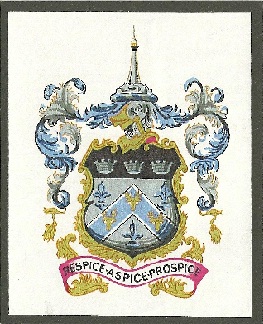 ggggggggggggggggggggggggggggggggggggggggggggggggg
ggggggggggggggggggggggggggggggggggggggggggggggggg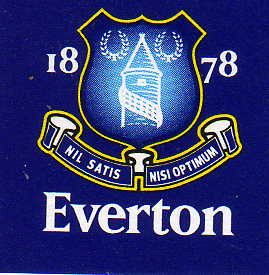
The present Merseyside Derby Games are contested between Everton and their close neighbours Liverpool. The event attracts a capacity crowd to the home ground of Everton at Goodison Park where, in 1894, the two sides had met for the in a Football League match. The occasion also taxes the capacity of the Liverpool ground at Anfield. Here the red favours, worn by the home supporters, dominate the location as the two clubs meet in the corresponding fixture while the Royal Blue colours of Everton, fill the section of the ground allotted to them as the visiting supporters. The location however, was once home to the Everton fans at a time when their main rivals came not from Liverpool, but from the small neighbouring Borough of Bootle.
Everton Football Club, founded in 1878, can trace its roots back to a Methodist chapel dedicated to St Domingo that once stood in the north end of Liverpool. Ben Chambers, at that time, ministered the chapel. Reverend Chambers had recently arrived in Liverpool from his birthplace, the Rugby playing stronghold of Huddersfield, so is unlikely that he brought with him any knowledge of the style of football that was played under the rules of the Football Association. Nevertheless, amongst the local congregation was a certain Thomas Evans a well-experienced football player who had learnt to play the association game back in his native Derbyshire. Tom Evans, under the watchful eye of the church elders, would have likely organized a series of impromptu soccer matches amongst the younger members of the congregation on a piece of land, laid out for public recreation, named Stanley Park. One year later the players severed their eccliasitacal roots and found new headquarters at the Queens Hotel in the district of Everton to which they changed their name. They continued to play their home matches on Stanley Park and, it was at this location, that they first played host to a team of players from St Johns, church in Bootle. Their curate, Alfred Keely, led the visitors.
The Reverend Keely had arrived in Bootle in spring of 1877 and, unlike his St Domingo counterpart, was well a versed in the game of association football. He had been born in Nottingham where, from as early as 1874, he is reported to be playing association football in the local newspapers. Alfred Keely won a place at Cambridge University were he played association football along with his friend William Chapman. Both men, on completing their studies, chose a living within the Church of England and were posted to churches on Merseyside. Alfred Keely was sent to St Johns parish on Brasenose Road, Bootle and immediately set about organising a football side from amongst the younger members of his congregation.
The first recorded game between Everton and St Johns, took place on the 10 th February 1880, at Stanley Park. The Everton side appeared to be made up of local players that were strengthened by one or two friends of Tom Evans. The make up of the Bootle side however, was completely different. The team included Alfred Keely along with his two brothers Erasmus and Edwin plus his friend William Chapman. The side also contained two local brothers by the name of Albert and Charles Allsop.
The style of play produced by Bootle St Johns proved far superior to that of Everton and, with a brace of goals from Edwin Keeley, they won the game be 2 goals to 0. The sides met again, at the same venue, two weeks later and Bootle St Johns again proved superior by winning the game by 4 goals to nothing. Their next encounter took place, 1 st march 1881, on Stanley Park.
Alfred Keely, through weight of his ecclesiastical duties, was forced to hand over the reins to Robert Sloane an experienced football player from Glasgow. The name St Johns was dropped from the title and the side became known simply as Bootle.
Everton had also gained the services of a Scotsman. His name was Jack McGill and he had begun his football career playing with Kilmarnock Portland in his native Ayrshire. Bootle, who arrived with just eight players, was forced to borrow three players from a side who played under the name of “The Liverpool Association”. Everton also acquired the services of one player from the afore named club and it was he, Knightly, who secured an Everton victory by scoring the only goal of the game.
The meeting of the two clubs was now beginning to capture the interest of the indigenous population and over 500 of them gathered around the open playing area when, 14th January 1882, the two sides next met on Marsh Lane, Bootle. They were several new faces in the Everton line up while their opponents, apart from Sloane and Albert Allsop, were now made up of former local public school men and it was one such player, Harold Baxter, who gave Bootle an early lead. The rest of the game however, belonged to Jack McGill who, with two goals each side of the interval, gave Everton a 4-1 victory. Bootle now lost the services of their founder, Alfred Keely.
The Reverend Gentleman was assigned another parish in Wimbledon and his departure prompted an exodus of all the public school players from Bootle. They left to form a new club, which they called Liverpool Ramblers. Frank Brettell took the over the secretarial duties at Everton while Robert Lythgoe, a well experienced player from North Wales, did likewise at Bootle. The two men were to become instrumental in formation of Liverpool & District Football Association when it was formed in October 1882.
Bob Lythgoe was present in the Bootle side when they next met Everton at Marsh Lane on 2 nd December 1882. Mr. Lythgoe had used his connections to engage the services of Scotsmen John McInnes along with Rod Ashton a “seasoned campaigner” who had learnt his football in his native Darwen. Jack McGill was absent from an Everton that included a couple of recent signings from North Wales.
The match took place on the Bootle Cricket enclosure on Irlam Road where Rod Ashton was absent as the played commenced. Bootle, thanks to goal from Grayson, was leading 1-0 by the time he took his place on the field. Ashton quickly “stamped his mark” on the game and it was he who scored the second and final goal to give Bootle a 2-0 victory. The two clubs had now developed a large following of fans and, when they next met, their numbers would overpower the occasion.
The return fixture took place on Stanley Park on 20 th January; 1883.The reappearance of Jack McGill raised the spirits of Everton followers who were anxious to avenge the defeat their favourites had sustained at Bootle earlier in the season. However Bob Lythgoe was equal to the occasion and along with Ashton and McInnes he had further strengthened his side by adding a promising young player from the Midlands, His name was J.Brodie and he had recently signed for Wolverhampton Wanderers. The game was reported to have attracted 1,500 people who swamped the unguarded playing area and intruded up on the field of play. Everton thought they had taken an early lead but the referee disallowed the goal for a previous infringement that had been committed by a Bootle player. The decision was a disappointment to the followers of Everton. The atmosphere further intensified when, midway through the second half; Bootle took the lead courtesy of goal from Albert Allsop.The crowd, as the excitement increased, frequently brought the play to halt by pouring over the parameters of the pitch. The game was eventually to end in chaos but there were no reports, in the local newspapers, of the crowd resorting to violence. The Liverpool Courier had their penciller well placed and he left us with this account of what he witnessed…
Rod Ashton got the ball at his toes and, dodging all the Evertonians, he finished with regular whizzed, the ball striking the bar and going over. Ashton claimed a goal that was objected to. The scene following this beggars description, the spectators flocking around the players in hundreds, the referee being lost in the crowd. Whilst this was taking place Frank Brettel kicked the ball out and H. Williams ran it through the Bootle goal. As all the forwards were still in the crowd, and the referee did not see what took place, he refused to allow the goal. Thus one of the best - contested games in the district ended in most unsatisfactory manner .
Seven days later, the two sides faced each other again in the penultimate round of the inaugural Liverpool knockout tournament. Bob Lythgoe, to celebrate the occasion, persuaded Thomas Johnson Britten to join the Bootle team. He was a quality player who had already played International football for Wales.
The match took place on the Liverpool College Ground in Fairfield where the class of Britten was evident from the start. It was the Welshman who gave Bootle an early lead then set up two further first half goals that were scored by J Grayson. Everton, trailing 3-0 at the interval, battled hard and reduced the arrears with a goal from Cartwright. This was, alas, all they could offer and they retired beaten by 3 goals to 1. Bootle then went on to lift the trophy at the expense of Liverpool Ramblers in a game that was also played on the ground of Liverpool College. The new Liverpool FA had chosen this venue because it was enclosed and the proceeds, which were collected at the gate, all went to a local charity.
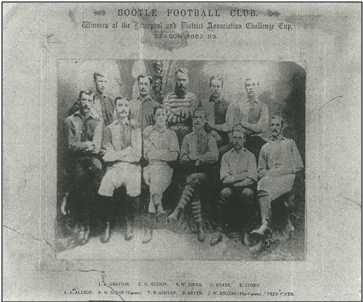
The Bootle Team.
First Winners of the Liverpool Cup.
14 April 1883.
The 1882/83-football season was to prove a turning point in the development of the game on Merseyside and both sides were to benefit from the experience. The local population was now attending football matches in great numbers but they were not, as yet, paying for the privilege. Both Bootle and Everton had previously completed fixtures with teams from the mill towns of East Lancashire in which they had suffered heavy defeats. This was due, partly, to the excellent players they had imported from Scotland who, it was rumored, were getting paid for their services. The leading clubs from Bolton and Blackburn, had also built an enclosure to which a fee could be changed at the gate. The money generated by this venture made it possible to take part in home and away fixtures with best sides in the Kingdom.
Bootle and Everton, to improve their standing, now needed to do the same.
Everton immediately set about constructing a simple enclosure on a section of land that they had rented from a certain Mr.Cruitt on Priory Road. The fate of Bootle however, was now in the hands of the local council who wanted to develop the cricket ground on Irlam Road. Another recreational facility, for the benefit of the local inhabitants, would shortly be built at Hawthorne Road. The two clubs were, temporary homeless and, due to this uncertainty, did not arrange fixtures with each for the forthcoming season.
The new Everton ground opened in September 1883 while the Hawthorne Road ground was not ready for occupation until the following November. Everton would now have to pay rent to their Landlord while the football players of Bootle would become the tenants of their local cricket club. Hawthorne Road, complete with its new cricket pavilion, was now the best sports ground on Merseyside and it enabled Bootle to host football matches with such famous teams as Queens Park, Glasgow and the aristocratic Corinthians from London. Everton, on the other hand, were struggling to attract quality teams to Priory Road. The local football fans, it would appear, were not prepared to part with their money to watch sides that were not of the quality as that of the leading sides from east Lancashire. Everton soon themselves in arrears with the rent and were asked to leave the ground by the Landlord.
They turned for help to their President Mr. John Holding who secured for them a new ground on Anfield Road. The pre-arranged fixtures, between the two clubs, could now recommence.
Mr. John Holding had thrown his financial weight behind Everton who now began to develop an enclosure at Anfield. Bob Lythgoe meanwhile, had become the President of the Liverpool FA and Mr. Henry Heard had taken over the reins when Everton paid their first visit to the new Bootle ground at Hawthorne Road. Ashton and Brittan were now missing from the Bootle line up but they had secured the services of Welsh International J. A. Eyton-Jones. Everton, led by their skipper Jack McGill, had now enlisted most of the best players from the Liverpool area into their ranks. There were about 1,000 people, who had paid to enter, on the ground to see Everton, with goals from Scott and McGill, race in to a 2-0 lead. A late goal from D. Williams was not enough to prevent Everton from registering their second win over Bootle.
The number of spectators had nearly trebled when, on the 31 st January 1885, the two sides next met on the new Everton ground at Anfield to contest the third round of the Liverpool Cup. They had all paid to enter. The two sides played out an exciting cup-tie but at the end of the ninety minutes the score line was blank. The game then went in to extra time. Bootle, with a goal from Johnstone, looked to have won the tie but Everton, with pronounced slope now in their favour, stormed back and, with late goals from Whittle and Parry, won the game by 2 goals to 1. Everton then completed a seasonal treble over Bootle by beating them 3-1 at Anfield on the 7 th of March.
The two clubs, with a regular source of income, could now afford to employ professional players. George Dobson joined Everton from Bolton Wanderers along with George Farmer and “Job” Wilding who had previously been playing their football in North Wales. Bootle, meanwhile, had brought in Scotsmen from the Dumbarton area, The Veith Brothers, Tam and Billy, had made a permanent move to Bootle while several other of their fellow countrymen, were on trail at Hawthorne Road.
The clubs, during the closed season, arranged back to back fixtures the first of which took place at Anfield on 2nd September 1885.George Farmer quickly endeared himself to the Everton faithful by scoring one of goals in a 2-0 victory for Everton. The two sides, having found themselves with a vacant Saturday, played a hastily arranged game at Anfield that ended in 2-2. A single goal, scored by “Job” Wilding, was enough to give Everton the victory laurel when the two sides met again in the return match at Hawthorne Road. Each game had attracted of around 2,000 customers. The season's excitement however, was far from over.
Bootle and Everton had now battled their way through to final of Liverpool Cup and the game produced the largest crowd yet to witness a football match in Liverpool. The match took play at Walton Stiles. A now defunct football club, who had played under the name of the Liverpool Association, had originally laid out the ground that had once stood on Goodison Road.
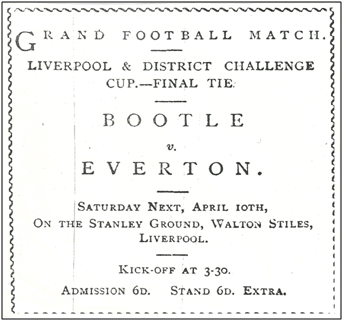
The new tenants, Liverpool Stanley, had recently taken possession of the venue and assembled a simple enclosure in to which a crowd of 8,000 had managed to be shoe horned inside. The trophy was to end up in the hands of Everton skipper George Dobson whose side won the game courtesy of a single goal that was scored by “Job” Wilding. The proceeds of the game again went to a local charity. The defeat had been a disappointment for the team from the Estuary town but a chance for an early revenge was to come from a most unusual direction.
The Liverpool Athletic Club had recently moved to a new location at Fairfield and, as a means of advertising this new venture, offered the local football teams to compete for a silver shield that was to be awarded to the winners of a soccer tournament that was to be staged on their ground. Eight clubs took part and, true to form, the final was contested between Bootle and Everton. The game however, ended in pandemonium and caused the first of several rifts that were to occur between the two clubs.
It was a warm and sultry Whit Monday evening when the play commenced on a pitch that was framed by around 8,000 noisy and boisterous spectators. Mr. W.H. Bailey, a venerable player with Liverpool Ramblers, consented to take charge in the middle and, by the end of the game, surly must have regretted his decision. Bootle made bright start and, following some early pressure, took a deserved lead. They continued to dominant to play until, following a rare attack by Everton, the Bootle goalkeeper was forced to punch out a shot from under the crossbar. The Everton players appealed for a goal and the umpire appealed to the referee to pass judgment. Mr. Bailey, much to the disdain of the Bootle players, awarded a goal. Their anger further intensified when Mr. Bailey, on an appeal from the Everton umpire, disallowed what the Bootle party thought was a perfectly good goal. The game was eventually settled in extra time with a goal, scored in favour of Everton, However, the Bootle executive claimed all the vital decisions had gone in favour of Everton and they refused to concede defeat. A heated argument now broke out between the two sides that resulted in the Athletic Club Committee withholding the trophy. It was later awarded to Everton.
Both sides, during the closed season, had been busy in the transfer market and Bootle signed “Job” Wilding from Everton. The Hawthorne Road club had also signed a promising young centre-half from Church whose name was Jonny Holt. Everton had signed Liverpool born Jimmy Costley from Blackburn Olympic the player who had scored the winning goal in 1883 FA Cup-Final. The Anfield club also made overtures to his brother Tommy.
The two clubs meanwhile, were at Loggerheads and no fixture between them was arranged for the forthcoming football season. Fate, however took a hand drawing the two clubs to face each other in the first round of Liverpool Cup. The game produced scenes never previously witnessed on Merseyside as over 10,000 people laid siege to the Hawthorne Road ground. They were long queues at the entrance gates as the kick off time approached and many people, fearful of missing the game, swarmed over the hoardings and increased the pressure on the spectators who were already packed tightly around the pitch. The ropes around the periphery frequently gave way under the pressure and the club Stewards had to work hard to keep them from intruding up on the playing area. Both captains, before play commenced, complained to the referee who noted their protests.
The two sides tore in to each other from the start with tackles going in thick and fast. The excitement soon had the crowd pouring through the ropes and several times was the game held up while the playing area was cleared. The home fans though their favourites had taken the lead but the Bootle umpire, showing great integrity, informed the referee that the ball did not hit the target. Bootle had much the better of the first hour play but it was the visitors who took the lead. A sports journalist, watching the match, described the goal
Briscoe was stood offside but the goalkeeper whose nerves would doubtless be a little upset by the yelling of small boys who got as near to him as they could, let the ball slip, put Briscoe on side, and the little Evertonian lost no time in registering the first goal. It would be folly to attempt to describe the scene of excitement, which followed, the cheers were so deafening that it was a relief when the globe was once more set rolling. (Football Field.)
The goal put heart in to the Everton players who soon increased their lead thanks to goal curtsey of Richards. Time began to run out for Bootle and with a couple of minutes left to play, the referee's whistle sounded for a “throw in”. The Everton fans, thinking the game was over, invaded the field and chaired their players back to the pavilion. The Bootle players also left the field while their skipper, Tam Veith, appealed to the officials to finish the game. A long debate then ensued before the Everton players re-appeared on the steps of the pavilion. Bootle however, failed to join them and, after much deliberation, the tie was eventually awarded to Everton. The relationship between the two clubs was now at ” a very low ebb” and, once again, no fixtures were arranged for forthcoming football season
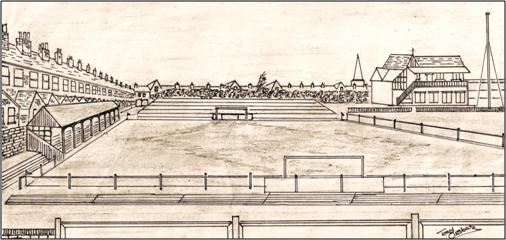
The Hawthorne Road Ground, Bootle.
The close season however, was to see an increase in transfer activity as both clubs brought in players from North of the Border. Cassidy Dick Goudie and Murray Watson arrived at Anfield while Bootle surprised their rivals by signing Scottish International player Andrew Watson from Queens Park. (He is now accepted to be the world's first black football player.) Izatt and Weir, two itinerant Scotsman, also agreed to play for Bootle and it was the action of these two players that was to deepen the rift that already excised between the two clubs.
Izatt and Weir, it was announced, had been selected to play for Bootle against Workington in a FA Cup tie at Hawthorne Road. The two players never arrived. They chose instead to travell with Everton for their cup-tie at Bolton Wanderers. The incident further angered the Bootle executive who accused their rivals, by offering them more money, of pouching away their players. They were however, to have the last laugh on the subject.
Bootle easily disposed of their Cumbrian opponents while, Everton, after eliminating Bolton Wanderers, became the subject of an FA inquire concerning the eligibly of several of their players. The two sides, meanwhile, had once again been drawn against each other in Liverpool Cup.
The football world was awash with talk of the intended formation of a new Football League and both Bootle and Everton had their application firmly” on the table”. Victory, in the forthcoming cup-tie was vital for both clubs, as it would strengthen their claim to represent Merseyside in the new venture.
The Merseyside Derby game was now beginning to attract the interest of football enthusiasts from outside the area prompting the Football Field, a leading sports paper based in Bolton, to send along one of their leading journalists who left us with this account of what he had witnessed…..
The manners of a Marquis and the morals of a Methodist was hardly the combination you expected to find at Anfield to day when the blue and white standard of Everton FC floated gaily over a wild conglomeration of wildly excited partisanship such as is seldom witnessed in this or any other country. The merry clicking of the turnstiles started around 1oclock and never ceased even for a moment until sometime after the combatants had engaged in battle The Bolton rivalry between Wanderers and Halliwell or the Blackburn competition of Rovers and Olympic in their most heated periods, never appear within measurable distance of the present engrossing struggle for the Liverpool championship. The Bootle enthusiasts are easily distinguishable, and they occupy a fair proportion of the overcrowded enclosure, the printed cards bearing the legend “Play up Bootle” conspicuously displayed in their hats Just before 2:25 The Bootle players arrived on the ground, and from the far corner, a hearty roar of cheering greeted them. They present a strong thickset appearance, of uniform height, solid and weighty. Five minutes later the quartered jerseys of Everton are visible emerging from the other end, and there is a spontaneous round of applause.
There was a crowd of around 12, 000 people present to see the sides line up as follows,
Everton: Joliffe, Dobson, Dick, Higgins, Gibson, Weir, Cassidy, Farmer, Goudie, Watson and Fleming.
Bootle: Jackson T. Veith A. Watson A. Allsop, Holt, Woods, Wilding, Morris Lewis Anderson and Hastings.
The game that followed was reported to be a disgrace and the least spoken about it the better. Old wounds were re-opened as the sides “fought in out” on the pitch leaving several players injured. Everton, eventually, won the game 2-0. The local press was quite guarded with their comments but our friend from Lancashire was critical and had this to say…
I have spoken to many of those who were present at the match and have been met on all hands with expressions of sorrow, of anger, of disgust at the sport to which we were treated. As a result of the match, there were three players seriously hurt. Weir of Everton had his shoulder put out, Hastings, of Bootle, received a most cruel and painful hurt, whilst Morris, of the same club, got an ugly kick on the head. Dick emerged from the contest as he might from a brawl, with a black eye, and many other players will not readily forget the heavy charged and cruel kicks (Football Field, 10 th December 1887.)
The delight felt in the Everton camp was soon shattered when the result of the FA inquiry reached their ears. The investigating committee, having considered the facts placed before them, found the Anfield club guilty of “ persuading players to join them by financial inducement” and closed their ground for one month. Everton, who had already been eliminated from the FA Cup, were also banned from entering the tournament for one season. The Liverpool FA then banned them from taking any further part in the local knockout and reinstated Bootle who went on the win the tournament. However, it was Everton and not Bootle who were selected to become founder members of the new Football League.
The decision was a blow to the Bootle executive who though their claim to be included was just a strong as that of their neighbours. Nevertheless; there was no other town in England who had more than one team included amongst the founder members. The Football League games now became the main attraction in Liverpool and large crowds became a regular feature on the Everton ground at Anfield. Jonny Holt decided his ambitions were best served by a move to the Football League and he left Bootle to join an Everton side that was also strengthened by the signing of Edgar Chadwick from Blackburn. The Anfield club had also captured the signature of Nick Ross from Preston North End who was considered to be the highest paid player in the country.
Bootle, in order to protect their future, joined a combination that had been formed by the leading clubs who had been left outside the new Football League. They replaced Jonny Holt by signing Billy Hughes and exiled Welshman living in Liverpool. Rob Jamieson was signed from Dumbarton along with fellow Scot “Wattie” Campbell from Moffat. Everton now had a fixture list to honour so the two clubs first met on Christmas Day, 1888, at Anfield.
Incessant rain had been falling since early morning be this did not deter a crowd of around 16,000 pouring on to the ground. The sight of Jonny Holt wearing the colours of their rivals must had saddened the hearts of Bootle faithful as they watched their side hold their hosts to a 0-0 drew. The visitors were able to witness the many improvements that had been made to the Anfield ground and all the spectators had a good view of game. Things were quite different when two sides met again at Hawthorne Road on the 3 rd of March.
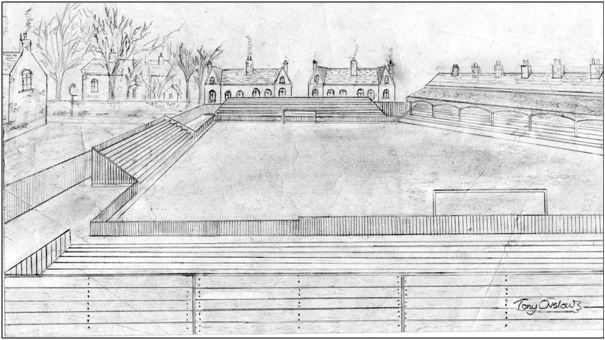
The Everton Ground at Anfield
The game attracted a crowd of around 10,000 with the Everton fans anxious to take look at Alf Millward who had recently arrived from Great Marlow. The Bootle executives were delighted with the attendance because the visitors had agreed to let them pocket all of the gate receipts. The early arrivals, who naturally occupied the best vantage points forced many of the latecomers, who had paid the 6d entrance fee, to offer as much as 2/6d for one of the few seats remaining on the grandstand. They were to get valve for money. Bootle had surprised Everton by racing in to a 3-1 lead before a late rally by the visitors earned them a 3-3.
Everton had now completed what had been a disappointing first season in the Football League finishing in eighth place. The lack of goals had been their problem with only Stoke, who had finished bottom scoring fewer goals. They had also, in the course of the season, failed to beat Bootle so the two sides agreed to a third meeting at Anfield in April 1889. The match drew in a crowd of over10, 000 people.
The visitors surprised their hosts by taking the lead after just three minutes. Everton then laid siege to the Bootle goal but could find no way past goalkeeper Davie Jardine who had recently joined them from Scotland. Nonetheless, the Everton pressure at last “paid off” and a goal from Parry brought Everton level at the interval. The home fans, which now sensed a victory, were surprised by the style of play produced by the visitors during the second half. The men from Hawthorne Road kept up the pressure and snatched a famous victory with a goal from the veteran player Frank Woods. The result stunned the Everton directors and prompted the following comments from a newspaper reporter…….
They is no question now as to the settlement of the local championship. The Liverpool cup holders vindicated their position as the premier club of the district, and this position should again secure them a place the eighteen excepted teams in the English cup competition next season. If further enhances the claim for consideration to the League. (Football Field)
The Everton wasted no time in addressing their goal scoring problems by signing Fred Geary from Nottingham Rangers and Scotsman Alex Brady from Sunderland. Nick Ross had decided to return to Preston and Alex Hannah and Danny Doyle, to fortify the defence, had been brought in from Scotland accompanied by Alex Latta a “much sought after” wing player from Dumbarton Athletic. The new signings did much to improve the performance of an Everton side that was lying second in league when they next face Bootle over the Christmas Holiday at Anfield.
Bootle, in the meantime, had become founder members of the Football Alliance along with such sides as Sheffield Wednesday and Newton Heath. Financial restrictions had reduced their recent signings to a couple of local players but they were, nevertheless, also amongst the leaders of the Alliance.
The currant form of both sides attracted an enormous crowd who quickly put pressure on each entrance the enclosure. The weight of the crowd was especially heavy on the Anfield Road gate that gave way allowing many people to see the game for nothing. Order was soon restored but the ground, when kick-off time arrived, was taxed to capacity.
Overnight rain had fallen and players struggled on a pitch the resembled a swamp. The home side, the pronounced slope in their favour, scored twice in the first half. They continued to dominant the game and Bootle were indebted to goalkeeper Dave Dunning for keeping the score line respectable. Nevertheless, Alex Latta beat the young Scot again, for a third time. No further goals were scored leaving Everton to re-establish themselves as the leading club in the district.
The game between Bootle and Everton was now as popular as ever with local football followers who flocked to Hawthorne Road when the return fixture was played in April. They numbered around 10,000 people. The Bootle committee had now enlarged the grandstand and added a terrace behind the Stanley Road end of the ground. It was here that the main body of Bootle supporters had established themselves leaving the Everton followers to congregate on two undeveloped sides of the ground. There was also a surprise awaiting them as the residents of Bootle unleashed their new terror weapon on up their visitors. The Bootle Bull, a loud dockside foghorn, roared out to greet the appearance of the Bootle players as they arrived on the field. The noise, re enforced by the Bootle supporters, appeared to unsettle the Everton players who conceded two goals in the first half of the game. The Bull however, later left the field and the visitors, roared on by the their own large following, staged a come back as the game ended in 2-2 draw. Two weeks later, the side's met again in the Liverpool Cup Final.
The reserve elevens of both sides, had seen their respective clubs through to the final but now, with honour at stake, the game was to be contest by the senior players. The neutral venue law was waved aside and, following the toss of the coin, the match was staged at Hawthorne Road where a crowd of 8,000 watched Everton retained the trophy with a 4-1 victory.
Dark clouds now hung over Hawthorne Road where the deep financial crisis threatened the very existence of the Bootle club. Everton, on the other had, were having no such problems. Their new signings had proved an instance success and they had finished the season in second place behind the all-conquering Preston North End. The Everton directors, on hearing the plight of their neighbours, quickly arranged for them to visit Anfield and allowed all the gate money to be given to Bootle. Six thousand people watched the game that was played on the first Saturday of September. Everton won by 3 goals to 2. The match generated a profit of £125 all of which was handed over to the Bootle treasury. The game was mark the last appearance of Albert Allsop in the Bootle colours. He had taken part in the first ever meeting between Bootle and Everton at Stanley Park and had appeared in more games, between the two clubs, than any other player.
The Hawthorne Road club then benefited from a mid-week visit from double winners Preston North End. The League Champions drew in a crowd of over 8,000 and beat Bootle by nine goals to nothing.
The size of the defeat stunned the Bootle executive but for the time being, they were safe from liquidation. Their neighbours Everton however, had now developed in to an excellent team. They had secured the services of Bootle goalkeeper Davie Jardine and, on the 6 th of February 1891, they were just one match away from securing the Football League Championship when they next met Bootle.
The currant season was also being enjoyed by Bootle who was lying second behind Sheffield Wednesday on the Football Alliance. They had now developed a following of around three thousand fans most of whom helped swell the attendance to around 13,000 when the sides met at Anfield They were soon cheering as Murray, a former player from Everton, gave Bootle a first half lead. The home side, “looking strangely of sorts” had re-organised their side by the time Edgar Chadwick brought them level. They then submitted the Bootle timbers to a heavy bombardment but were thwarted by some excellent goalkeeping from Davie Dunning their new signing from Glasgow. The visitors appeared to have held out for a creditable draw until, in the last minute, a low shot from Alex Latta found its way agonizingly through the tangled legs of the Bootle defenders to give Everton a 2-1 victory.
So it was that, on the 14 th March 1891, Everton were crowned Football League champions of England while Bootle finished second to Sheffield Wednesday in the Football Alliance. A request for fixtures now poured in to Anfield from all parts of the Kingdom but the executive still found time to visit their neighbours at Hawthorne Road who they beat by 2 goals to 1. The visit had generated a crowd of over 6,000 people most of whom returned at the location four weeks later when the sides again clashed in the Liverpool Cup final.
Bootle directors welcomed the occasion because the extra revenue, coming so late in the season, eased their financial burden for a while. The final round of the local knockout still found favour with the people of Merseyside and over 8,000 of them watched the Anfield club retain the trophy with a 4-1 victory. Their triumph however, was merely another nail in the coffin of Bootle Football Club who was now tottering on the brink of extinction. If they were going to survive, then they needed to join their neighbours in the top level of English football.
Bootle again applied for election to the Football League but their request was turned down in favour of Sunderland who was voted in favour of Stoke. Bootle once, again took their place in Alliance. The average gate at Anfield was now the highest in England while the attendances at Hawthorne Road were less than one fifth of that number. Still the club, in attempt to re-enforce their side, again sent their agents to search for promising young players amongst the less fashionable football cubs in Scotland. Moonie and Moore from Dundee Wanderers along with Mulloch from Our Boys Dundee came south for a trail period while J Dickson moved north from Lincoln. “Wattie” Campbell left Bootle for Everton who had also signed Rob Kelso from Renton. The new players all had a chance to impress when, on the 5 th of September, Bootle opened their season with a visit to Anfield.
Rain was falling as the sides lined up but this did not deter over 7,000 people from attending the game. Everton, playing like champions, were two goals to the good inside ten minutes. They continued to outclass the men from Hawthorne Road and, at the final whistle, they had beaten them by seven goals to nil. This was the heaviest defeat ever inflicted up on Bootle by Everton. Still the visitors had shown a remarkable resilience in what had been a most debilitating set of circumstances. In deed only one foul, by Parry of Everton, had been committed throughout the entire game.
No return fixture had been arranged between the clubs but on the 26 th of February; they met in what was to be the one and only Lancashire Cup tie to be played between them. The surface of the Anfield ground was covered with snow and Bootle made a protest that was not sustained. There was 8,000 inside the ground to see Edgar Chadwick score two first half goals for Everton. A late second half goal from Wylie then completed the scoring as Everton won the tie by 3 goals to 0. The £70, collected at the gate, was divided equally between the participants. This process was repeated when the sides met for third time in the semi-final of the Liverpool Cup.
The game, which attracted 6,000 spectators, took place on an overcast April evening at Anfield. Bootle put their strongest available eleven in the field but there were several second team players in the home team. Things looked bright for Bootle when Finlayson gave them and early but Everton drew level with a goal from Geary. Darkness soon began to engulf the ground and, somewhere in the gloom, the winning goal was “scrimmaged through” by the Everton forwards.
The Football League now annexed the Alliance and Bootle thus became founder members of the League Division Two. It was hoped that this might ease the deep financial debt that threaten the very existence of the Hawthorne Road club Their hopes however, would all be in vain.
Meanwhile, over at Anfield, charge was in the air and the now famous split between certain members of board resulted in Everton decamping from Anfield and moving on to a new purpose build football ground on the other side of Stanley Park. They named the ground; Goodison Park and Bootle were to play here only once.
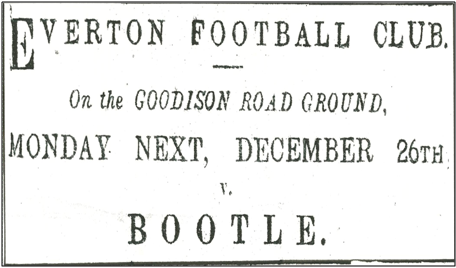
The game took place over the Christmas Holiday and it attracted a crowd of over 14,000 people. Alex Latta gave Everton an early lead before a goal from Greirson brought Bootle level. No further goals were scored and the game ended in a 1-1 draw. The next meeting of the two clubs was to be their last
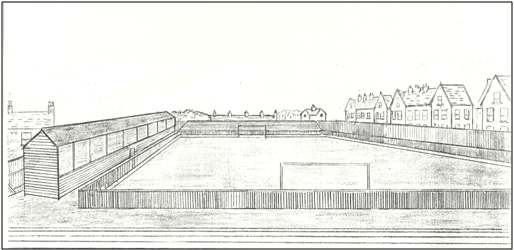
Goodison Park, 1893
The game took place on the 12 th of April 1893. The Everton first eleven were competing in Glasgow on the evening when Bootle and Everton met in the Liverpool Cup at Hawthorne Road so the Goodison Park club sent over their second string of players to fulfill the fixture. A crowd of 1,500 watched the game. The disparity between the two clubs was now so great that the Everton reserve side was strong enough to give them a 2-1 victory.
Bootle Football Club was now running at a loss with the wage bill alone being greater then the amount of money being taken at the gate. Away trips to such places as Lincoln and Grimsby were also a drain on the clubs meager resources. The main problem however, was the clubs close proximity to an Everton club whose success had slowly drawn away the customers from Hawthorne Road. The Bootle club now went in to liquidation and thus became the first team to resigned from the Football League. Future Merseyside Derby games would now be fought out between Everton the new tenants at Anfield, Liverpool. The games, between these two clubs, would soon intensify and develop in to fierce rivalry we easily recognise to day, but how different it might have been had Bootle managed to acquire a rich sponsor.
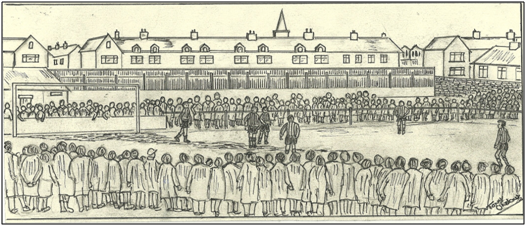
Hawthorne Road, 1890.
Themanfromthehillcountry@hotmail.com
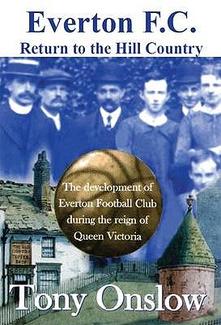
The Original Merseyside Derby Game
By "Tony Onslow"
The Original Merseyside Derby Game
The Tony Onslow Collection - E-Mail - Themanfromthehillcountry@hotmail.com...
Everton Independent Research!